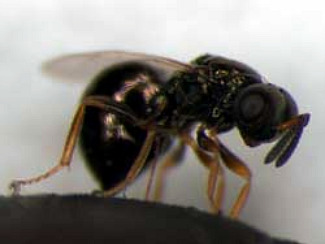Genome sequencing of three parasitoid wasps

Parasitoid wasps are four times smaller than the common fruit fly. They lay their eggs within other insects and kill their host before leaving. Although their size is insignificant, their importance in the control of populations of agricultural pests is crucial. Thanks to these insects billions of euros worth of crops are saved each year. Not only that, but the genus Nasonia is very useful for research carried out in genetics, given that the males evolve from non-fertilised eggs and only have one set of chromosomes, and it is therefore immediately possible to detect the effects of chromosomes which have undergone mutations. In experiments in which mutations take place, the altered genes are easily detected because there is no copy of the gene which could mask the effects.
The research, which recently was published in the journal Science, shows the full sequencing of the genome of the species Nasonia vitripennis, Nasonia giraulti and Nasonia longicornis. It also points out key discoveries made with these sequencings, such as the identification of the genes responsible for the venom produced by wasps. Scientists have identified 79 different proteins in this venom, 23 of which had never been observed before. This information could be very useful in the development of new drugs, since these proteins have important physiological effects on the cells of their hosts. With the complete sequencing of these genomes, research also can identify the genes that determine which specific insects will be attacked by this parasitoid wasp, as well as the specific food needs of its offspring at large scale.
The sequencing has led to important discoveries. A set of nuclear and mitochondrial genes have been discovered which evolve much more rapidly than usual, and which could accelerate the process of formation of new species. Researchers also observed bacterial and virus genes included in the genome of the wasps. These findings have helped to better understand the genetic mechanisms regulating the evolution of living beings.
Dr Deodoro Oliveira is postdoctoral researcher and lecturer in Genetics at the UAB Department of Genetics and Microbiology. His research focuses on the distribution and evolution of the transposable element Galileo in the genus Drosophila. The follow-up to his research consists in molecular approximation aimed at the study of evolutionary problems. He has worked on Nasonia genetics and genomes and on the intracellular bacteria Wolbachia at the laboratory of Dr John Werren at University of Rochester, New York. Prior to that Dr Oliveira worked on the study of evolutionary relations of the genus Drosophila at the American Museum of Natural History of New York.


